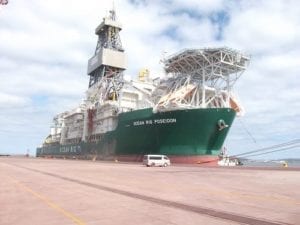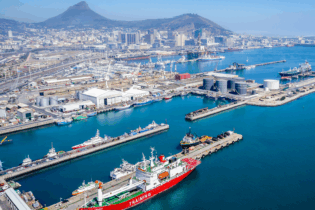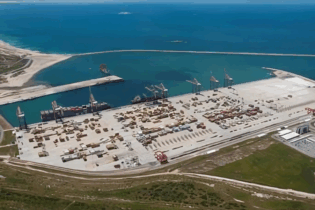 The Port of Saldanha remains the largest and deepest natural port in the Southern Hemisphere. Port manager Willem Roux tells Transport World Africa how it is mitigating the global commodity crunch.
The Port of Saldanha remains the largest and deepest natural port in the Southern Hemisphere. Port manager Willem Roux tells Transport World Africa how it is mitigating the global commodity crunch.
It is able to accommodate vessels with a draft of up to 20.5 m or 21.5 m with the harbour master’s advance permission. Saldanha is unique in that it has a purpose-built rail link to mines in the Northern Cape. At the port, iron ore stockpiles are connected to the ship loaders via a conveyor belt system for the efficient loading of iron ore.
The terminal remains the largest iron ore export facility in Africa and boasts the largest storage facility for crude oil – 45 million barrels in South Africa. A number of new aquaculture projects, as well as a salmon farming pilot project, were launched at the port in line with Operation Phakisa.
Its long-term objectives include becoming a dual function as a specialist in repair and fabrication, and a distribution hub for the oil and gas industry. Transnet National Ports Authority (TNPA) is in the process of launching infrastructure developments aimed at attracting investment through the adoption of a public-private partnership in order to establish fit-for-purpose infrastructure that will enable economies of scale in serving the oil and gas industry.
Phakisa’s priorities
Three priority projects have been earmarked for the port under the South African government’s Operation Phakisa initiative:
• the formation of an off-shore supply base (OSSB) – the country’s first dedicated and customised facility supporting offshore oil and gas activities
• a rig repair facility at berth 205, at a length of 380 m and a depth of 21 m, to comfortably accommodate two rigs at a time
• a new finger jetty in the vicinity of the port’s Mossgas quay, which will be 500 m long, 8.5 m deep and with 12 m pockets, to accommodate floating docks for vessel building, repairs and maintenance.
Construction on the OSSB is under way and a transaction advisor is assisting TNPA with the appointment of an operator for the facility. TNPA is seeking international investment for the construction of the deep-water oil-rig repair berth and the jetty in the vicinity of the Mossgas quay.
Integrating efficiency
The port collaborates with role players in the logistics chain in order to design efficient, effective and safe logistic solutions as part of reducing the cost of doing business. In this process, instances of double-handling of cargo are minimised. At the same time, the port has set performance standards for terminals, road and rail operators, as well as marine services, to ensure that services rendered are in line with best practice while asset utilisation is optimised.
Creating economies of scale holds great potential for reducing costs and is a primary consideration when designing logistic solutions and port services.
In August 2015, the port went live with TNPA’s R79 million web-based IPMS (Integrated Port Management System). IPMS replaces manual processes and enables key port operations to be managed online and in real-time.
Transnet is also optimising port land utilisation, and deploying advanced technology and equipment in operations in order to increase capacity across its ports and terminals to ensure that capacity is created ahead of demand.
The port’s terminal operator has a comprehensive dust mitigation programme in place to manage the nuisance factor associated with iron ore dust fallout. This includes an on-site car wash facility, which makes it possible for vehicles to be washed prior to exiting the port.
Collaboration between the Saldanha Bay Industrial Development Zone (IDZ) and the port is contextualised in a memorandum of understanding that will facilitate the ease of doing business. As the IDZ will be declared a customs-controlled area, there will be numerous benefits accrued to operators in the IDZ.
 The Port of Saldanha remains the largest and deepest natural port in the Southern Hemisphere. Port manager Willem Roux tells Transport World Africa how it is mitigating the global commodity crunch.
The Port of Saldanha remains the largest and deepest natural port in the Southern Hemisphere. Port manager Willem Roux tells Transport World Africa how it is mitigating the global commodity crunch.







